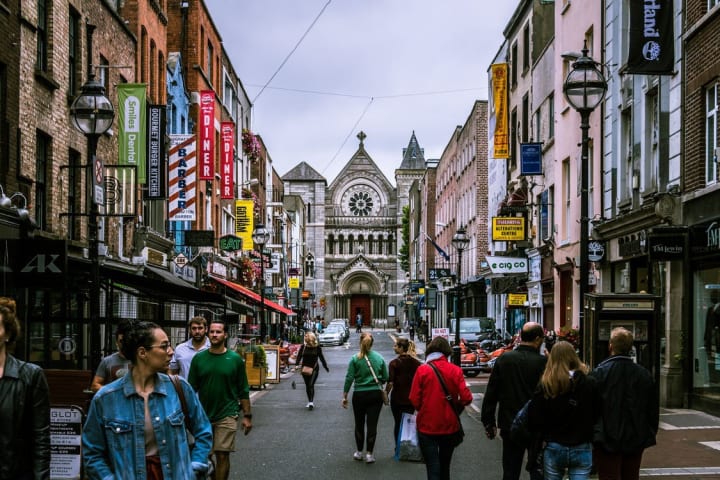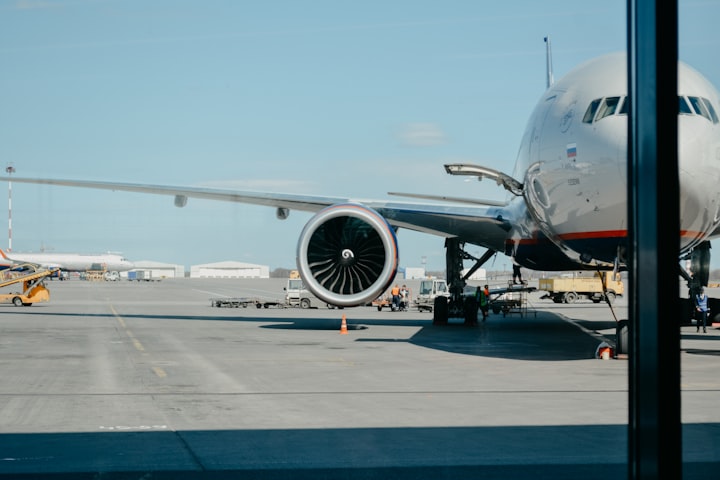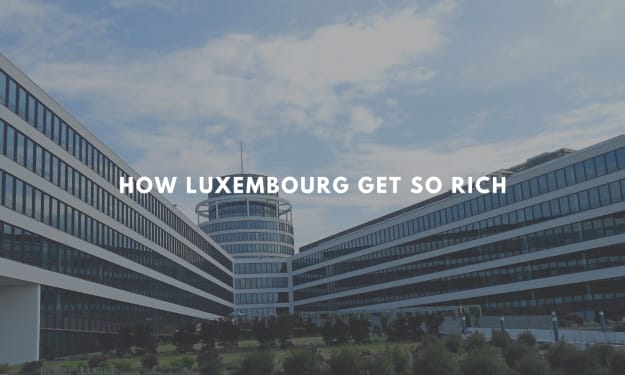Why Ireland Is So Rich
How Ireland Become The Fifth RICHEST In The World

Ireland is the fifth richest economy measured by GDP per capita, just below Luxembourg and Bermuda.

It has a smaller population than New York. But still, it has become a go-to place for international businesses like Apple and Microsoft, which place their European headquarter on this tiny island.
Ireland was not always this rich. The Irish Potato Famine was a period of mass starvation and disease in Ireland from 1845 to 1849. a million people died of famine, and more than a million fled the country. It significantly declined its population.

That’s why today, more Irish people live in the United States and around the world than in Ireland.
But how did this tiny nation like Ireland go from starvation to become so rich in the last three decades?
Early Years of Economic Development

Before Ireland became an independent country in 1922, Ireland was part of the British empire, where Irish people were considered second-class citizens.
When Ireland gained independence from Britain in 1922, At the time, Irish people saw that free market economies like the United States were going through the great depression.
But communist economies like the Soviet Union were experiencing rapid industrial growth.
It seems to the new Irish administration that they will be better off by implementing protectionist policies. So Ireland started to monopolize and nationalize its corporations. It also banned most foreign trade and investment in the country.
Ireland put high tariffs on all imported goods to discourage importing from other economies. The goal of this policy was to make Ireland a self-sufficient economy.
It was a mistake because protectionism may work in the short term. But in the long run, it can be a devastating blow to the nation’s economy.
Protectionism may work in countries that have a large population and a vast amount of natural resources. But in countries like Ireland, which did not have both of them. Protectionism seldom worked, and the Irish government soon realized it.
In 1957, the Irish government started encouraging foreign investment and slowly lifted trade barriers to improve economic growth.
It turned nationalized corporations into private companies to compete in the private market and become more efficient.
With low taxes, the Irish government also created a free economic zone outside Shannon airport to attract multinational companies.
These economic policies worked, and many international companies started coming to Ireland to establish their European headquarters.
In 1980, Apple established its headquarters in Ireland. But none of these things made life better for Irish citizens because companies would just set up their offices in Ireland with some accountants rather than creating jobs. They transfer their earrings to Ireland to avoid paying taxes.
The Sick Man of Europe
In 1973, Ireland joined the European Union which further helped to improve its economic growth. But things in the 70s and 80s were again getting worse.
With the oil crisis of the 70s, unlimited government spending with a tax rate of as much as 50 percent for the average Irish person worsened the economic situation in Ireland.

Unemployment in 1987 reached 17%, and Irish people once again started migrating to foreign countries for work and worsening the economic crisis in Ireland.
To solve these economic difficulties, the Irish government started a program called the Tallaght strategy, in which all the political parties presented their economic reforms to solve the crisis.
To get out of the crisis, the government cut down on spending and cut taxes. So people spend and invest more, which improves the economy. These expansionary policies change Ireland’s economy forever
Irish Economic Miracle

Companies were coming to Ireland because of its low taxes rates. But Irish government did not want multinational companies to set up their tax headquarters with few accountants; instead, it wanted them to hire Irish people to improve their standard of living.
The Irish administration in the 80s asked; What are the obstacles foreign businesses are facing in hiring Irish people?
One of the reasons for this was labor legislation which was so strict that hiring and firing made difficult, which made corporations reluctant to hire Irish people.
So the government started liberalizing its labor legislation and other policies to make it easier for businesses to hire in Ireland.
These policies soon worked miraculously, as businesses began employing Irish people and improving the economy.
Throughout the 1990s and early 2000s, Ireland was called by many people the Celtic tiger because of its enormous growth.

From 1995 to 2000, Ireland’s economy grew consistently at a rate of 9 or 10 percent. It outpaced any other economy in that period. In 1980, corporate tax rates were 50%, one of the highest in the world.
But in the early 2000s, corporate tax rates were just 12.5, one of the lowest in the world. This reduction in the tax rate was an incentive for many foreign businesses to arrive in Ireland.
With low taxes and low ECB interest rates, many people domestically were starting companies that were fueling the economic growth in Ireland.
Ireland During The Financial Crisis of 2008

The global financial crisis of 2008 hit Ireland’s economy particularly hard because of its interconnectedness to the United States and Europe.
The financial crisis of 2008 in Ireland was due to the property bubble fuelled by excessive lending by the banks to anyone with low income to buy luxury real estate.
Banks thought property prices won’t go down significantly, and it was safe to hold property as their collateral for the loan. But the unexpected happened, and property prices fell by 12.4% in 2008.
In 2009, property prices fell further by 18.6%. In big cities like Dublin, house prices were down 56% from their peak.
In January 2009, the number of people living on unemployment benefits had risen to 326k, the highest monthly level since the record began in 1967.
Unemployment increased from 6.5% in July 2008 to 14.8% in July 2012.
In 2010, the Irish government sought help from the IMF and European Union to bail out financial institutions from falling, which would further worsen the economic situation.
22.5 billion USD from IMF, 22.5 billion USD from the European Union, and 17.5 billion USD from the Irish government were provided for the rescue deal to stimulate the economy and bail out financial institutions.
This rescue deal soon showed results as the Irish economy began to recover from the crisis in 2012 and started growing in 2013. but this came at a cost though the government had to shut down 41 government institutions and cut the salaries of civil servants by 14% to pay back loans from the IMF and EU.
Leprechaun Economics
Ireland quickly recovered from the crisis and economic growth comeback in the economy.
In 2015, Ireland reported a growth rate of 25%. It alarms economists like Paul Krugman, who started investigating the real reason behind these huge growth numbers. Not even China achieved 25% growth in a single year, and many economists realized this number is a delusion.
Paul Krugman famously described this incident as leprechaun economics.

The real reason for this growth rate was multinational companies like Apple and Microsoft, Which were moving their profit to Ireland to benefit from low taxes. This incident shows that statistics don’t always reflect reality.
The IMF estimated that 60 percent of Irish foreign direct investment was just sitting in the bank accounts.
Nobody believes our GDP numbers anymore, not after a 26 percent jump in 2015, which was famously derided as “leprechaun economics”. Even the CSO cautions against viewing last year’s [2017] 7.8 percent jump as a reflection of real economic activity
— The Irish Times, 17 March 2018
That’s why Ireland uses many different metrics to measure its growth because classical economic metrics like GDP growth rate don’t always reflect reality.
On 13 July 2016, the ex-Governor of the Central Bank of Ireland made the following comment:
The statistical distortions created by the impact on the Irish National Accounts of the global assets and activities of a handful of large multinational corporations have now become so large as to make a mockery of conventional uses of Irish GDP.
— Patrick Honohan, ex-Governor of the Central Bank of Ireland,
For years, Many multinational companies took advantage of Ireland’s low taxes and created tax schemes where they pay little to no taxes. But it had to change as Ireland is starting to increase its corporate tax rates from 12.5 to 15 percent.
So the economic growth slowdown and international companies go away from Ireland?
Well, probably not, Attracting multinational companies is not as simple as lowering taxes.
Over the years, These companies had invested hundreds of billions in Ireland to build the right infrastructure, which took a lot of time. It makes it hard for companies to find alternatives to Ireland.
Conclusion
Many people don’t know that Ireland is an airline powerhouse. Many multinational aircraft leased companies currently operate in Ireland.

Ireland manages nearly 22% of the fleet of aircraft worldwide and a 40% share of the Global fleet of leased aircraft.
The country is one of the largest exporters of pharmaceuticals, medical devices, and software-related goods and services.
Today, the Irish economy is diversified, and even in the COVID crisis, its economy was still resilient and continued growing.
Ireland went from a poor and third-world country to a highly advanced economy. Ireland became a European headquarters for international corporations because of its stable political and economic system.
Continue Reading:
How George Soros Made a Billion Dollar Betting Against Britain
About the Creator
Arsalan Haroon
Writer┃SEO Expert┃Investor






Comments
There are no comments for this story
Be the first to respond and start the conversation.